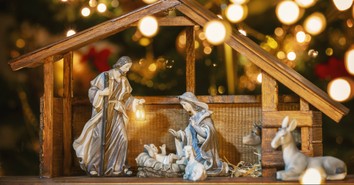Burial Box Could Provide 'Concrete' Proof that Jesus Rose

For nearly 2000 years the significance of a small, stone box remained hidden from human history.
But 12 months ago - within days of Easter - the world awakened to a concrete truth carved in limestone: Jesus did rise from the dead, and now it was possible to "touch" his resurrection as well as talk about it.
When Andre Lemaire first happened upon the "James ossuary" last April, he did not know just how important the burial box would become. The owner of the box, a Jew from Tel Aviv whose hobby was collecting ossuaries, mentioned to Lemaire that he had a box that might be of interest.
Lemaire, who is an authority on Semitic script, took one look at the carving on the box - which at one time held the bones of James – and determined that it could be the first archeological proof that Jesus did actually live - and that he had a brother.
The words on the ossuary read in Aramaic "Ya`akov bar Yosef achui d'Yeshua," which translates to "James son of Joseph brother of Jesus."
There is little doubt, even among non-believers, that Jesus actually walked the earth in the first century. But seeing it set in stone somehow makes the truth seem all the more real.
As Lemaire told Time magazine last year, "The written word is a bit airy. Listen, you can talk about Egyptian civilization, but the day you visit the pyramids, it speaks to you in a different way."
More importantly, the resurrection itself becomes even more tangible.
"James was in the box and Jesus was on the box because of the resurrection," said Ben Witherington III, co-author with Hershel Shanks of The Brother of Jesus, a new book that explains the story and meaning of the first archeological link to Jesus and his family.
Witherington, who is Professor of New Testament at Asbury Theological Seminary in Lexington, Ky., explained that the inscription shows how James ultimately switched from cynicism toward Jesus to believing that his brother was the Messiah and, ultimately, to becoming the head of the church in Jerusalem.
"James was put in the box because of the sure hope that he would be resurrected," Witherington said. "And he only becomes the head of the Jerusalem church because he saw his brother raised from the dead."
Until that happened, James was like the rest of his siblings in thinking Jesus was nothing more than a strange-minded messianic pretender who had a knack of embarrassing his own family, (Mark 3:20, 31-35) Witherington said.
And if not for the resurrection, James' ossuary never would have included the reference to Jesus.
"Jesus would not have been on the box if he had not been resurrected, because until that happened he was nothing more than a crucified rabbi whose life ended in shame," Witherington said. "Crucifixion never was seen as a noble way to die. It's a most horrible way for a human being to die. There's no redeeming value in crucifixion."
But then Jesus appeared to James (1 Cor. 15: 7) and suddenly everything changed - at least for James, who became a key figure in the early stages of Christianity and also was a pioneer of Jewish-Christian reconciliation.
Ironically, the issue of Jesus having a blood brother has the potential to, as Witherington puts it, "reopen old debates and even older wounds."
No doubt when the carved inscription was translated, it immediately inflamed passions in several different areas. Was this the actual ossuary of the James, the brother of Jesus? Did Jesus even have a brother? And if so, what part did he play in the progression of the Christian Church?
While Protestants have held that Jesus did in fact have blood brothers (and sisters), the Roman Catholic Church maintains the "perpetual virginity" of Mary and thus that Jesus could have no blood siblings. The Orthodox faith asserts that James was the son of Joseph by a previous marriage.
Witherington points out in his book how the Roman Catholic and Orthodox traditions are based on inaccurate interpretations of scripture, but he stresses that he does not want the ossuary to create further tension.
Instead, he hopes that the discovery of James' ossuary will reemphasize the importance of James and of Jewish Christianity, while also asserting the significance of Jesus' message on first-century listeners.
"The first thing that (the ossuary inscription) underlines and punctuates is the Jewishness of the holy family," Witherington said. "They practiced the popular burial custom of the day ... and were thoroughly Jewish and proud of their family relationship."
Ultimately, however, the ossuary points us to Jesus.
James, who once resented his brother, became willing to be martyred (stoned) for his beliefs. That his ossuary includes not only the name of his father, but also his brother, signals that Jesus was indeed a powerful presence in the first century - and beyond.
Learn more about The Brother of Jesus here.

Hershel Shanks is "probably the world's most influential amateur Biblical 
Originally published April 21, 2003.







